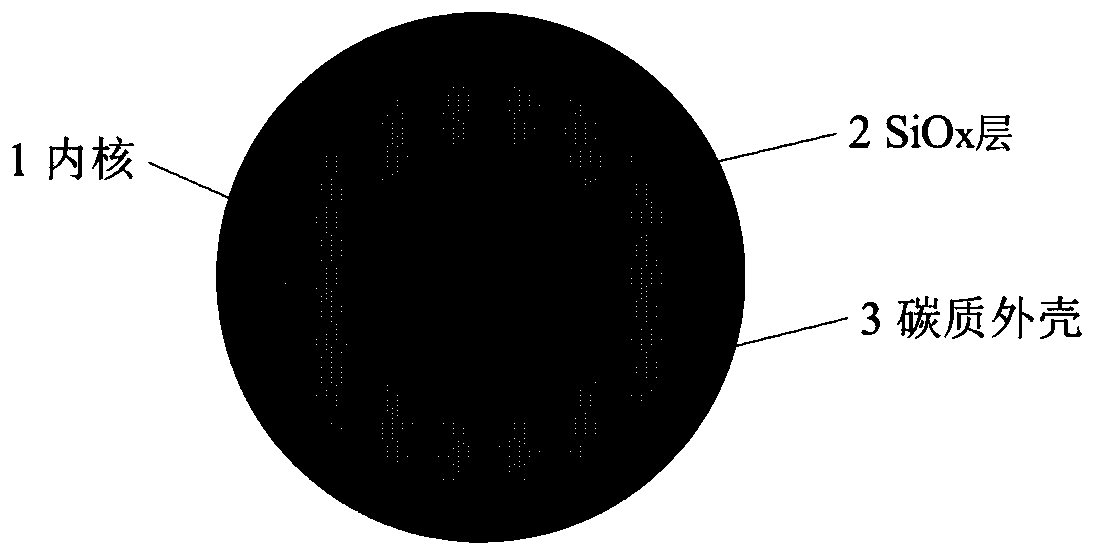SiOx-C composite negative electrode material with core-shell structure and preparation method thereof
A core-shell structure and negative electrode material technology, applied in structural parts, battery electrodes, electrical components, etc., can solve the problems of poor conductivity and difficult preparation of SiOx, and achieve high conductivity, high first Coulomb efficiency, and easy large-scale production. Effect
- Summary
- Abstract
- Description
- Claims
- Application Information
AI Technical Summary
Problems solved by technology
Method used
Image
Examples
Embodiment 1
[0039] (1) Place 100g of carbon black powder (CB) in an argon-protected tube furnace, and keep the temperature in the furnace at 250°C;
[0040] (2) After mixing 28g of silicon powder and 60g of silicon dioxide powder and compacting them evenly, place them in a vacuum tube furnace, keep the vacuum degree in the furnace at 50Pa, raise the temperature of the tube furnace to 1350°C, and keep it warm for 5h; and generate SiO x The gas is passed into the tube furnace in the previous step for surface deposition, and the gas flow rate is 20ml / min to obtain CB@SiO x composite materials;
[0041] (3) Combine 20g glucose with 10gCB@SiO x After mixing evenly, put it in a tube furnace, pass it into a nitrogen atmosphere for protection, and raise the temperature to 800°C for 6 hours to obtain CB@SiO x @C Composite anode material.
[0042] The four-probe test showed that the obtained CB@SiO x The electronic conductivity of the @C composite anode material is 0.18S / cm; electrochemical te...
Embodiment 2
[0044] (1) 50g of artificial graphite powder (AG) is placed in a nitrogen-protected tubular furnace, and the temperature in the furnace is maintained at 300°C;
[0045] (2) After mixing 28g of silicon powder and 66g of silicon dioxide powder evenly and compacting them, place them in a vacuum tube furnace, keep the vacuum in the furnace at 20Pa, raise the temperature of the tube furnace to 1450°C, and keep it warm for 4 hours; and generate SiO x The gas is passed into the tube furnace in the previous step for surface deposition, the gas flow rate is 50ml / min, and AG@SiO x composite materials;
[0046] (3) Mix 20g pitch with 10g AG@SiO x After mixing evenly, put it in a tube furnace, pass it into a nitrogen atmosphere for protection, and raise the temperature to 850 ° C, and the holding time is 6 hours to obtain AG@SiO x @C Composite anode material.
[0047] The four-probe test showed that the obtained AG@SiO x The electronic conductivity of the @C composite anode material ...
Embodiment 3
[0049] (1) 50g titanium dioxide (TiO 2 ) is placed in a nitrogen-protected tube furnace, and the temperature in the furnace is maintained at 300°C;
[0050] (2) After mixing 28g of silicon powder and 58g of silicon dioxide powder evenly and compacting them, place them in a vacuum tube furnace, keep the vacuum in the furnace at 50Pa, raise the temperature of the tube furnace to 1350°C, and keep it warm for 4 hours; and generate SiO x The gas is passed into the tube furnace in the previous step for surface deposition, and the gas flow rate is 200ml / min to obtain TiO 2 @SiO x composite materials;
[0051] (3) Mix 15g pitch with 10g TiO 2 @SiO x After mixing evenly, place it in a tube furnace, pass it into a nitrogen atmosphere for protection, and raise the temperature to 800°C for 5 hours to obtain TiO 2 @SiO x @C Composite anode material.
[0052] The four-probe test showed that the obtained TiO 2 @SiO x The electronic conductivity of the @C composite anode material is...
PUM
| Property | Measurement | Unit |
|---|---|---|
| particle size | aaaaa | aaaaa |
| particle size | aaaaa | aaaaa |
| electrical conductivity | aaaaa | aaaaa |
Abstract
Description
Claims
Application Information
 Login to View More
Login to View More - R&D
- Intellectual Property
- Life Sciences
- Materials
- Tech Scout
- Unparalleled Data Quality
- Higher Quality Content
- 60% Fewer Hallucinations
Browse by: Latest US Patents, China's latest patents, Technical Efficacy Thesaurus, Application Domain, Technology Topic, Popular Technical Reports.
© 2025 PatSnap. All rights reserved.Legal|Privacy policy|Modern Slavery Act Transparency Statement|Sitemap|About US| Contact US: help@patsnap.com



